The driving range one can get with modern, fuel-efficient vehicles is remarkable. The problem remains with human anatomy. Bladder capacity has not kept up with the pace of technology.
Indeed, while road-tripping to test the real-world range of the 2020 Hyundai Sonata Hybrid, I could not quite manage to edge right up to either the 590-mile range quoted by the trip computer or the theoretical 620 miles calculated from the 13.2-gallon fuel tank and the EPA combined rating of 47 mpg. It’s not Hyundai’s fault. I blame the misapplication of driver rehydration strategies and some inexplicable construction-induced traffic in Indiana. I simply had to bail for a truck stop, not knowing how long I’d be sitting in traffic otherwise.
I logged 504 miles over one day before nature called me to the fuel pump, which dispensed just over 11 gallons before clicking. That works out to a calculated average of 45.8 miles per gallon—a bit shy of the EPA rating, but certainly within the margin of error. I wasn’t hypermiling, after all—Indiana is a mind-numbingly dull state in which to drive, so judicious application of the “+” toggle on the cruise control switch made for a more rapid drive.
SEE ALSO: 2020 Hyundai Sonata Review
Maximum comfort
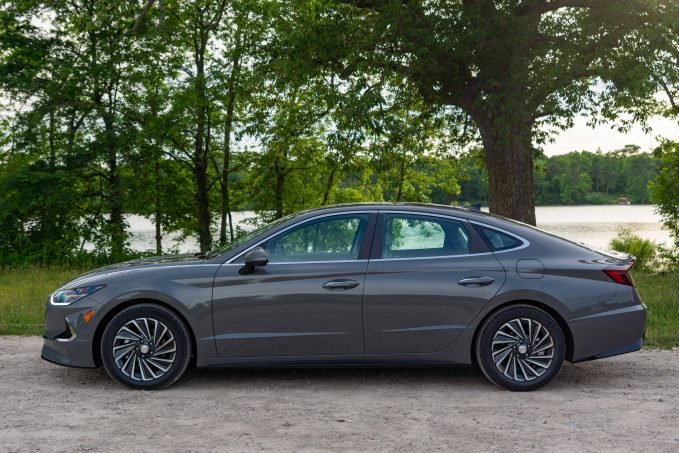
The miles wore easily. The ride quality over the weather-beaten pavement of the Midwest was excellent, with no harshness or loud noises over expansion joints or potholes. The steering was a tad light for my tastes, though it is direct and communicative. Importantly, the seats are nicely contoured and have plenty of adjustment range to suit most drivers. This is one of the best cars I’ve driven for a long day in the saddle.
The rear seats have plenty of leg and hip room, though the head room from the sloping roofline might become an issue for the very tall. I’m six feet, four inches and all torso, and my hair brushed the headliner when seated “behind myself.” But my legs were a couple inches from the seatback—very few adults would ever need more room in the second row than that given by this Sonata Hybrid. My kids, however, would like to see a second USB port in that second row, because tuning out the parents via their individual devices is critical on a roadtrip.
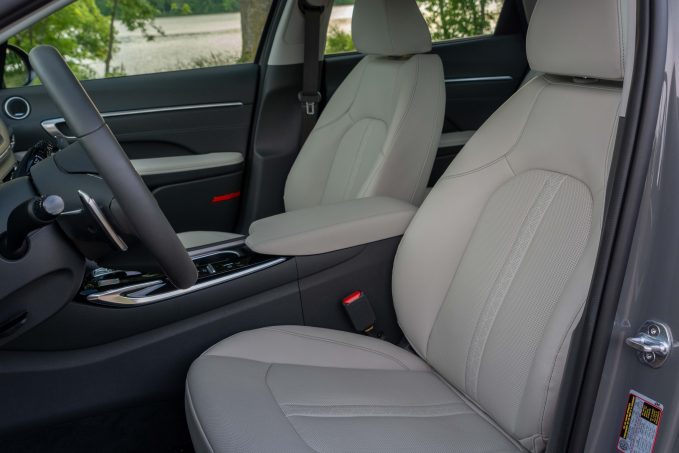
With 192 total horsepower from the combo of electric and combustion propulsion, the Sonata Hybrid has no problems getting up to highway speeds with alacrity. You do hear the gas engine light off when under full throttle, but the sound is well muted and isn’t objectionable. Shifts from the six-speed automatic are quick and basically imperceptible, with a more satisfying feel than one gets from the continuously-variable transmissions found in most hybrids.
SEE ALSO: 2018 Toyota Camry Hybrid Review
High tech isn’t hard to use
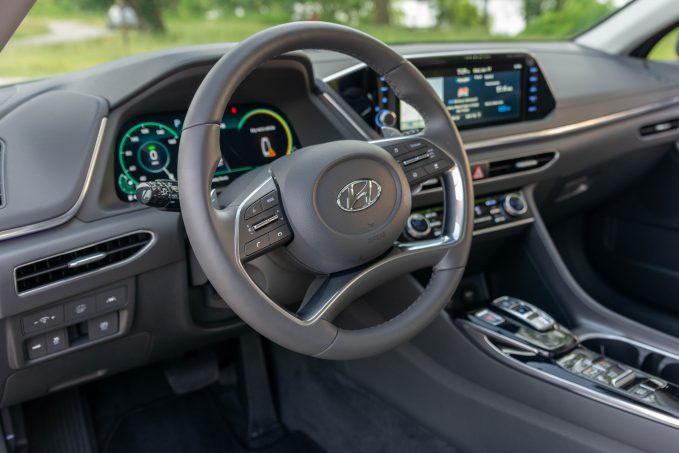
Oddly, I do notice that the audio system seems to compensate for the expected road noise that isn’t there – acceleration ratchets up the volume on the infotainment at speed a bit, and drops it accordingly as you slow to neighborhood speeds. It’s not objectionable, just a slightly odd behavior, as if the audio engineers didn’t have confidence that the drivetrain engineers could manage to keep the hybrid system quiet. Or the audio calibrations are unchanged between the hybrid and standard Sonata models.
One unusual feature that we might begin to see more of across many automakers is the solar roof panel. Here, instead of a heavy glass panoramic sunroof, we have a real sun roof—one that generates 205 watts of electricity. It’s certainly a conversation piece, but Hyundai quotes the solar panel as adding around two miles per day to the range of the Sonata Hybrid. It’s not like using a plug-in PHEV hybrid where one can leach twenty or more miles per overnight charge—it seems to be more geared to minimizing battery discharge when using HVAC and infotainment while parked. For that, it’s a wonderful feature: I’ve noted other cars with mild hybrid stop-start systems that will briefly shut off the HVAC fan (and thus the air conditioning) while sitting at a stop light. That’s a miserable experience when ambient temperatures crest ninety degrees Fahrenheit—it won’t happen when the solar panel is keeping the battery topped up.
SEE ALSO: 2020 Hyundai Venue Review
Beyond that quirk, I’ve long been a fan of Hyundai’s infotainment systems. These are among the best, easiest-to-use touchscreen solutions I’ve found. Everything works logically, with clear, simple screens displaying all of the most important information in a legible layout. On the 10.25-inch widescreen on this Sonata Hybrid, you can have multiple “pages” of info displayed. When using Google Maps via Android Auto on the leftmost two-thirds of the widescreen, a third page of other info can be displayed. I often used either fuel economy displays here, or the current satellite radio station when I tired of my Spotify playlists.
Those standout looks
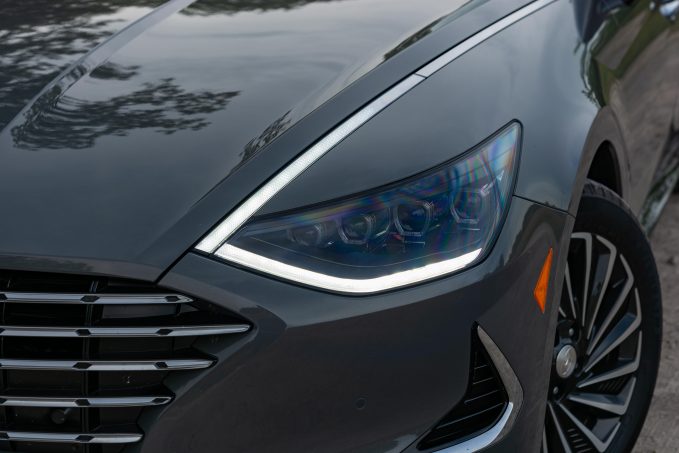
I was torn when I first saw photos of the Sonata Hybrid, and again in the sheetmetal. It’s an unusual look, with a low, sleek profile and an incredibly wide “mouth” for a grille. After a few walkarounds, however, the details jump out at you. It’s a striking sedan.
The detail that gets me is this LED extension of the daytime running lamps, continuing up and over the fender to where it blends with the chrome character line that surrounds the side windows. The chrome strip harks to the similar line found on the groundbreaking 2010 Sonata. It’s such a cool feature that I can’t help but marvel at it.
Verdict: 2020 Hyundai Sonata Hybrid
If you’re looking for something with a dash of style that can eat highway miles with ease, the 2020 Hyundai Sonata Hybrid is hard to beat. Just buy the tall coffee, not the venti.
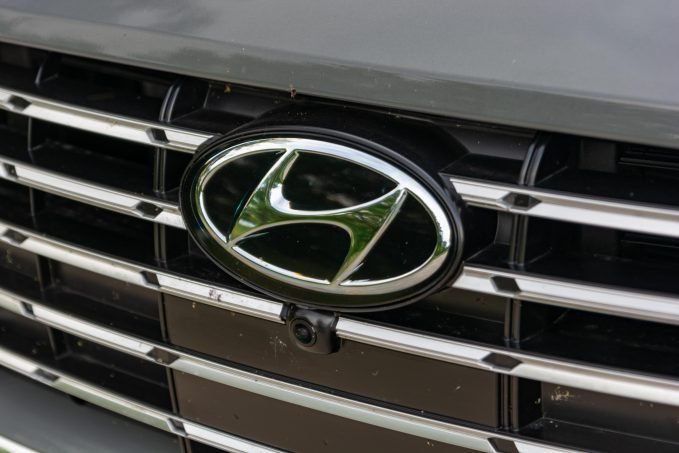
[Images: © 2020 Chris Tonn]


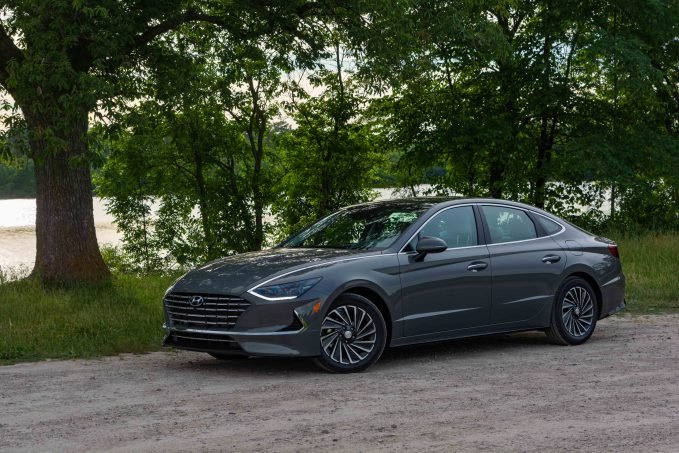
Leave a Reply